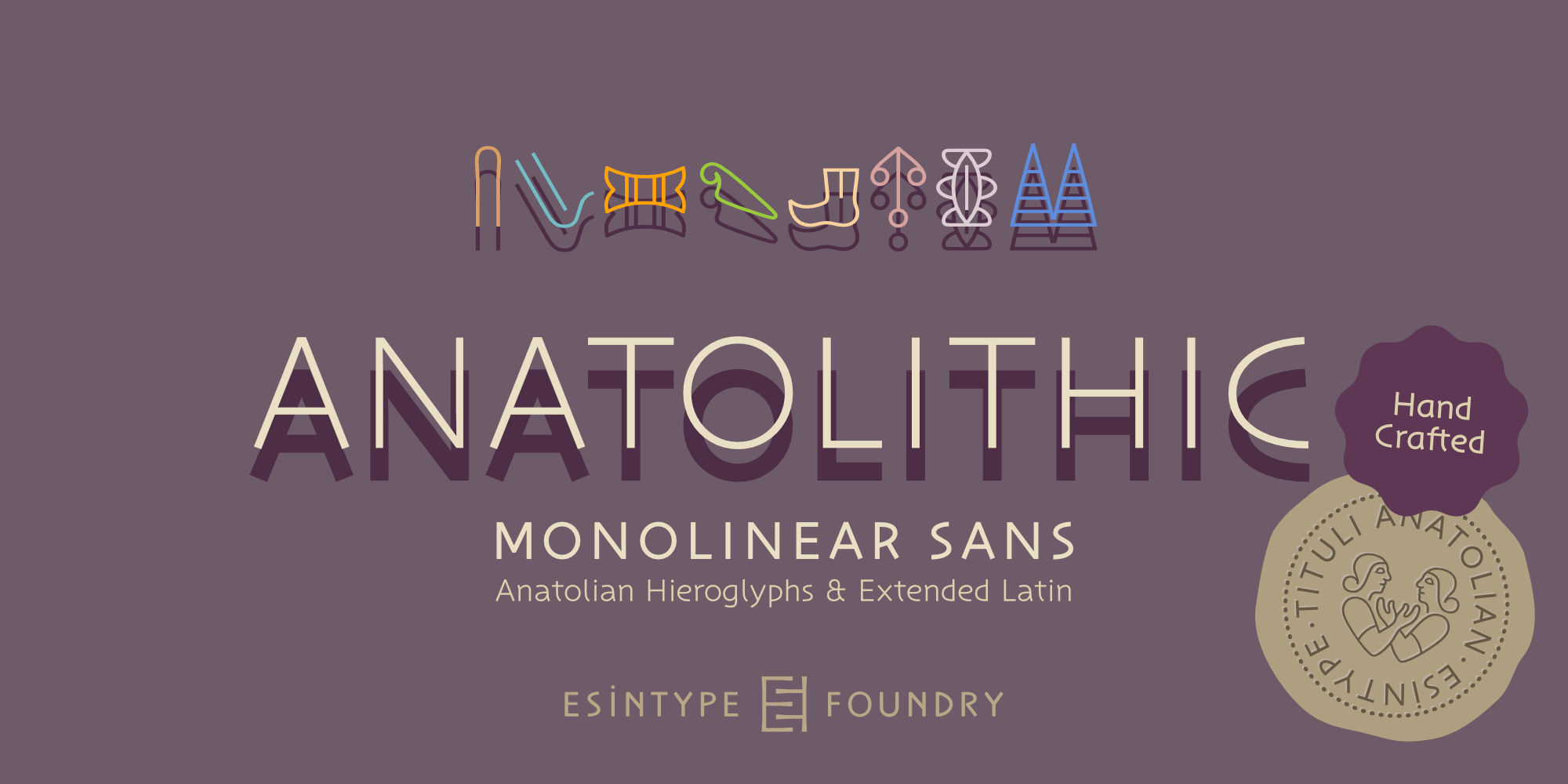Monolinear sans Anatolithic is available in seven multiplexed weights ranging from thin to bold, while all hieroglyphic Anatolithic Base is offered in five weights with a carefully crafted grades.
Anatolithic family
12 Fonts
Anatolithic Thin

Anatolithic Ultra Light

Anatolithic Extra Light

Anatolithic Light

Anatolithic Normal

Anatolithic Medium

Anatolithic Bold

Anatolithic Base 48

Anatolithic Base 56

Anatolithic Base 64

Anatolithic Base 72

Anatolithic Base 80

View and license at
About Anatolithic
Anatolithic is the complete and up-to-date version of the Anatolian Hieroglyphs and a monolinear sans typeface inspired by inscriptional letterforms of Anatolia’s multilingual past, said to represent the roots of Indo-European languages. The Latin script part acting as a companion to the Anatolian Hieroglyphs, and vice versa.
Anatolithic takes its name from the stone artifacts of Anatolia’s pre-Classical antiquity. Like ‘paleolithic’, it is derived from the Greek lithikos, meaning “of or pertaining to stone”. The term stone in this context refers to a substantial corpus of inscriptions, while the prefix of the noun indicates the origin.
Anatolithic has two concepts, each with its own glyph sets:
‘Anatolithic Base’ consists of the essential 583 glyphs, which are recognized as the complete Anatolian Hieroglyphs sign repertoire.
On the other hand, ‘Anatolithic’ contains 649 Anatolian Hieroglyphs among over 1200 glyphs, including additional signs as character variants and stylistic alternates. Guided by the cornerstone works of the field, additional forms derived from significant inscriptions and previously overlooked variants have been implemented as OpenType features.
Exclusively for Anatolithic, this concept features an extended Latin script set with a limited number of pseudo-hieroglyphic character alternates that could be considered for use as optional letterforms.
The contrast between the two scripts through the blending of certain characters makes Anatolithic a distinctive title alternative. Certain vowels are interchangeable between Latin and pseudo-hieroglyphic forms in all-caps typesetting. Those characters represent the vowels found in the nouns Anatolia/Anatolithic.
In addition to being a multiscript font, Anatolithic has an inscribed appearance that can be characterized by its uniform strokes, angled terminals, clean geometry, and large x-Height features. It has OpenType features such as small numbers, fractions, case-sensitive forms, ligatures, and more.
The character repertoire of Anatolian Hieroglyphs is based on Unicode tables originally adopted from Laroche’s catalog and subsequent publications. All signs in the Unicode block have been redrawn, in concordance with numerous sources, including on-site observations, corpus and recent studies, drawings and photographs.
Reference fonts have been re-examined, resulting in a number of improvements and refinements. In cases, the double-line drawing technique, used for archaeological documentation and merely shows the outline of the relief forms, has been reduced to a single line, as observed in late period inscriptions. In certain instances, the iconography has been enhanced by eliminating stylistic subjectivity.
Monolinear sans Anatolithic is available in seven multiplexed weights ranging from thin to bold, while all hieroglyphic ‘Anatolithic Base’ is offered in five weights with a carefully crafted grades.
The style of the Latin script in harmony with the modern humanist forms reflects the characteristics of a perennial look and can be used for a wide range of typesetting purposes.
Anatolithic is one of the seven typeface designs in Esintype’s ancient scripts of Anatolia project, Tituli Anatolian series — representing the Luwian and Hittite periods.
Additional Information
- Article covering features in depth (soon)
- Anatolithic release post
- Hawkins’ remarks on certain signs: Hawkins’ signary
- Our story on Anatolian Hieroglyphs: Journey through Anatolian Hieroglyphs
- Other Anatolian Hieroglyphs fonts and resources: Hieroglyphic Luwian fonts
- Our Bibliography page
Scripts
- Latin, Anatolian Hieroglyphs
Specifics
- Designer: Ali Riza Esin
- Creation Date: Jun 07, 2024
- Debut Date: Jul 04, 2024
- Format: OpenType TT
- Glyph Count: 1212 / 596
OT Features
aalt (Access All Alternates), case (Case-Sensitive Forms), ccmp (Glyph Composition / Decomposition), cv01–cv26 (Character Variants), dlig (Discretionary Ligatures), dnom (Denominators), frac (Fractions), kern (Kerning), liga (Standard Ligatures), locl (Localized Forms), mark (Mark Positioning), mkmk (Mark to Mark Positioning), numr (Numerators), ordn (Ordinals), sinf (Scientific Inferiors), ss01 (Flaws), ss02 (Veliisa Variants), ss03 (Pseudo-H-glyphic A, I, O, U), ss04 (Pseudo-H-glyphic A, I, O, U), ss05 (Pseudo-H-glyphic A, I, O, U), ss06 (Pseudo-H-glyphic A, I, O, U), ss07 (Pseudo-H-glyphic D, I, M, W, Y), ss08 (Single storey a), ss09 (Conventional B), subs (Subscript), sups (Superscript), zero (Slashed Zero)
Tags
Anatolian, Ancient, Archaeology, Archaic, Architectural, BC, Capitals, Caps, Carved, Chiseled, Clean, Decorative, Dingbat, Embossed, Engraved, Epigraphy, Headlines, Hieroglyph, Hieroglyphic, Hipster, Icons, Illustrative, Animals, Incised, Inscribed, Label, Lapidary, Multicultural, Linguistic, Mediterranean, Monumental, Multiplexed, Neoclassic, Oldstyle, Packaging, Palaeography, Pictogram, Pictograph, Picture, Relief, Roman, Sans, Stone, Symbol, Thin, Uniwidth, Versatile, Vinery, Viticulture, Wine
Other Details
Localized font names:
Anadolitik (TR), Anatolithic (EN), Anatolithique (FR), Anatolithisch (DE), Anatolitica (IT), Anatolitisk (SE), Anatolítica (ES)














